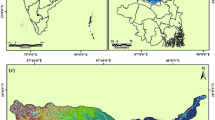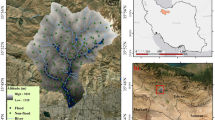Abstract
Flooding is one of the main natural hazards in Northern Europe and several areas of the Northern Boreal Hemisphere, where during intense rainfall events, several river basins are affected by a fast water level rise that may cause severe damage to human lives and properties. For these reasons, the development of flood models to identify susceptible areas is essential for decision-makers. Geographic Information Systems (GIS) are currently accurate and valuable support tools for defining flood susceptibility maps at different spatial scales. In this study, the prediction accuracy of different GIS-based procedures in the identification of flooding susceptibility is tested and compared. These procedures include the frequency ratio, a combination of the frequency ratio and logistic regression, a combination of the frequency ratio and Shannon’s entropy index, and the statistical index. Ten conditioning parameters of flooding susceptibility are considered: elevation, slope, curvature, land use, Topographic Wetness Index, Stream Power Index, hydrogeology, stream distance, flow direction and average annual rainfall. The comparison analysis is carried out by applying these methods to the study area of Devon County in Southwest England. A total of 225 flood events are used to define the models. For model validation, 1000 randomly selected training and testing sub-datasets have been used in the definition of the receiver operating characteristic (ROC) curves. The results show that the procedure based on the statistical index provides the highest accuracy and reliability in flood susceptibility predictions.




Similar content being viewed by others
References
Cao C, Xu P, Wang Y, Chen J, Zheng L, Niu C (2016) Flash flood hazard susceptibility mapping using frequency ratio and statistical index methods in coalmine subsidence areas. Sustainability 8(9):948
Chung CJF, Fabbri AG (2003) Validation of spatial prediction models for landslide hazard mapping. Nat Hazards 30(3):451–472
Dewan AM, Islam MM, Kumamoto T, Nishigaki M (2007) Evaluating flood hazard for land-use planning in greater Dhaka of Bangladesh using remote sensing and GIS techniques. Water Resour Manag 21(9):1601–1612
Gallopín GC (2006) Linkages between vulnerability, resilience, and adaptive capacity. Glob Environ Chang 16(3):293–303
Hall JW, Sayers PB, Dawson RJ (2005) National-scale assessment of current and future flood risk in England and Wales. Nat Hazards 36(1–2):147–164
Hulme M, Jenkins GJ, Lu X, Turnpenny JR, Mitchell TD, Jones RG, Lowe J, Murphy JM, Hassell D, Boorman P, McDonald R, Hill S (2002) Climate Change Scenarios for the United Kingdom: The UKCIP02 Scientific Report. Tyndall Centre for Climate Change Research, School of Environmental Sciences, University of East Anglia: Norwich; 120
Jayakrishnan R, Srinivasan R, Santhi C, Arnold JG (2005) Advances in the application of the SWAT model for water resources management. Hydrol Process 19:749–762
Khosravi K, Pourghasemi HR, Chapi K, Bahri M (2016) Flash flood susceptibility analysis and its mapping using different bivariate models in Iran: a comparison between Shannon’s entropy, statistical index, and weighting factor models. Environ Monit Assess 188(12):656
Kia MB, Pirasteh S, Pradhan B, Mahmud AR, Sulaiman WNA, Moradi A (2012) An artificial neural network model for flood simulation using GIS: Johor River basin, Malaysia. Environ Earth Sci 67(1):251–264
Köppen W (1936) Das geographische System der Klimate (Handbuch der Klimatologie, Bd. 1, Teil C)
Kourgialas NN, Karatzas GP (2011) Flood management and a GIS modelling method to assess flood-hazard areas—a case study. Hydrol Sci J 56(2):212–225
Lee S, Sambath T (2006) Landslide susceptibility mapping in the Damrei Romel area, Cambodia using frequency ratio and logistic regression models. Environ Geol 50(6):847–855
Lee MJ, Kang JE, Jeon S (2012) Application of frequency ratio model and validation for predictive flooded area susceptibility mapping using GIS. In: Geoscience and Remote Sensing Symposium (IGARSS), 2012 IEEE International. IEEE, p 895–898
Liao X, Carin L (2009) Migratory logistic regression for learning concept drift between two data sets with application to UXO sensing. IEEE Trans Geosci Remote Sens 47:1454–1466
Lim J, Lee K (2017) Investigating flood susceptible areas in inaccessible regions using remote sensing and geographic information systems. Environ Monit Assess 189:96
Massey DS, Denton NA (1988) The dimensions of residential segregation. Soc Forces 67(2):281–315
Muzik I (1992) Derivation of unit and flood hydrographs using a GIS. Environ Monit Assess 23(1–3):45–56
Naghibi SA, Pourghasemi HR, Pourtaghi ZS, Rezaei A (2015) Groundwater qanat potential mapping using frequency ratio and Shannon’s entropy models in the Moghan watershed, Iran. Earth Sci Inf 8(1):171–186
Niang N, Saporta G (2007) Resampling ROC curves. In: Ferreira C, Lauro C, Saporta G, Souto de Miranda M (eds) Proceedings IASC 07, Aveiro (Portugal)
O’Connell PE, Ewen J, O’Donnell G, Quinn P (2007) Is there a link between agricultural land-use management and flooding? Hydrol Earth Syst Sci 11(1):96–107
Oh HJ, Kim YS, Choi JK, Park E, Lee S (2011) GIS mapping of regional probabilistic groundwater potential in the area of Pohang City, Korea. J Hydrol 399(3–4):158–172
Pall P, Aina T, Stone DA, Stott PA, Nozawa T, Hilberts AG et al (2011) Anthropogenic greenhouse gas contribution to flood risk in England and Wales in autumn 2000. Nature 470(7334):382
Pradhan B (2010) Flood susceptible mapping and risk area delineation using logistic regression, GIS and remote sensing. J Spat Hydrol 9(2):1–18
Pradhan B, Dini Hairi Bin Suliman M, Arshad Bin Awang M (2007) Forest fire susceptibility and risk mapping using remote sensing and geographical information systems (GIS). Disaster Prev Manag 16(3):344–352
Pulvirenti L, Pierdicca N, Chini M, Guerriero L (2011) An algorithm for operational flood mapping from synthetic aperture radar (SAR) data based on the fuzzy logic. Nat Hazards Earth Syst Sci. https://doi.org/10.5194/nhess-11-529-2011
Rahmati O, Pourghasemi HR, Zeinivand H (2016) Flood susceptibility mapping using frequency ratio and weights-of-evidence models in the Golastan Province, Iran. Geocarto Int 31(1):42–70
Robson AJ (2002) Evidence for trends in UK flooding. Phil Trans R Soc A 360(1796):1327–1343
Shannon CE (1948) A note on the concept of entropy. Bell Syst Tech J 27(3):379–423
Sun D, Yu Y, Goldberg MD (2011) Deriving water fraction and flood maps from MODIS images using a decision tree approach. IEEE J Sel Top Appl 4(4):814–825
Tehrany MS, Pradhan B, Jebur MN (2013) Spatial prediction of flood susceptible areas using rule based decision tree (DT) and a novel ensemble bivariate and multivariate statistical models in GIS. J Hydrol 504:69–79
Tunstall SM, Johnson CL, Penning-Rowsell EC (2004) Flood hazard management in England and Wales: from land drainage to flood risk management. In: World Congress on Natural Disaster Mitigation, Vol. 14, p 447–454
Van Westen CJ, Rengers N, Soeters R (2003) Use of geomorphological information in indirect landslide susceptibility assessment. Nat Hazards 30:399–419
Vijith H, Madhu G (2008) Estimating potential landslide sites of an upland sub-watershed in Western Ghat’s of Kerala (India) through frequency ratio and GIS. Environ Geol 55(7):1397–1405
White I, Howe J (2002) Flooding and the role of planning in England and Wales: a critical review. J Environ Plan Manag 45(5):735–745
Youssef AM, Pradhan B, Sefry SA (2016) Flash flood susceptibility assessment in Jeddah city (Kingdom of Saudi Arabia) using bivariate and multivariate statistical models. Environ Earth Sci 75(1):12
Zerger A, Wealands S (2004) Beyond modelling: linking models with GIS for flood risk management. Nat Hazards 33(2):191–208
Zweig MH, Campbell G (1993) Receiver-operating characteristic (ROC) plots: a fundamental evaluation tool in clinical medicine. Clin Chem 39(4):561–577
Author information
Authors and Affiliations
Corresponding author
Ethics declarations
Conflict of Interest
The authors declare that they have no conflict of interest.
Additional information
Publisher’s Note
Springer Nature remains neutral with regard to jurisdictional claims in published maps and institutional affiliations.
Highlights
• A performance comparison of four different GIS-based procedures
• Development of flood susceptibility maps for Devon County (United Kingdom)
• Performance assessment via a receiver operating characteristic curve
Rights and permissions
About this article
Cite this article
Liuzzo, L., Sammartano, V. & Freni, G. Comparison between Different Distributed Methods for Flood Susceptibility Mapping. Water Resour Manage 33, 3155–3173 (2019). https://doi.org/10.1007/s11269-019-02293-w
Received:
Accepted:
Published:
Issue Date:
DOI: https://doi.org/10.1007/s11269-019-02293-w




